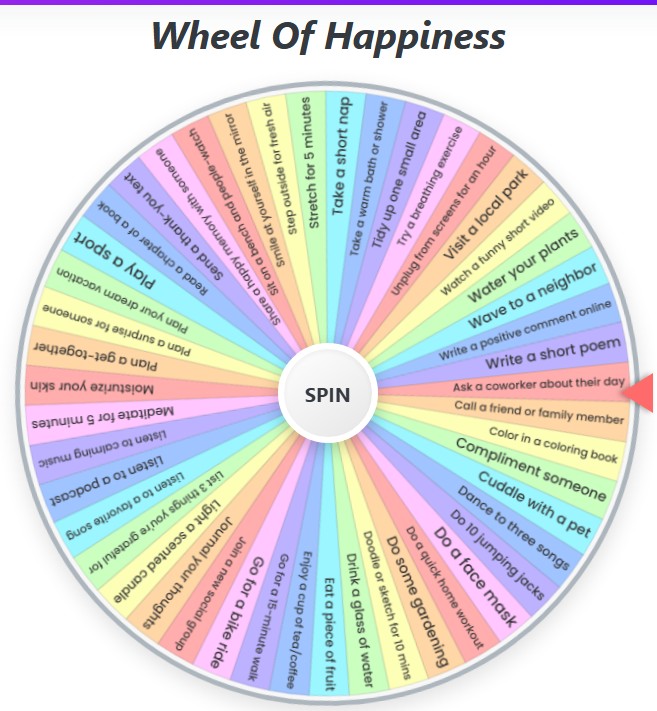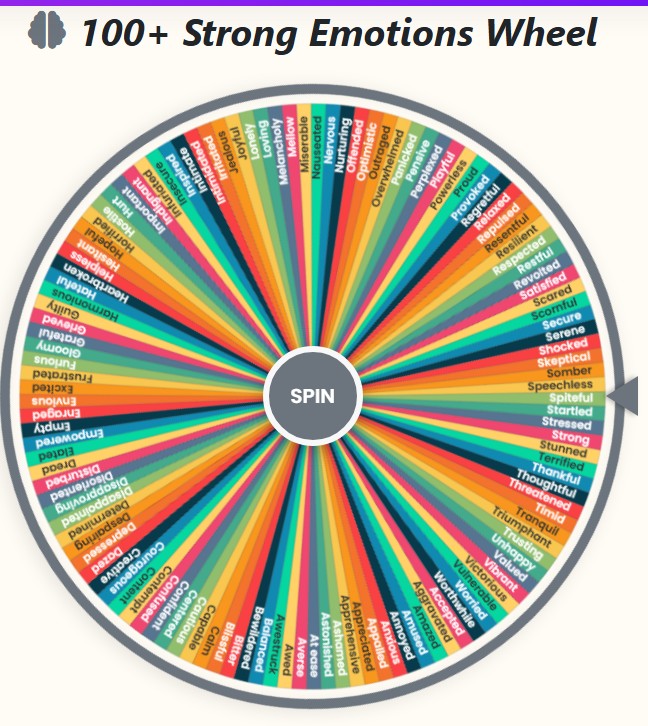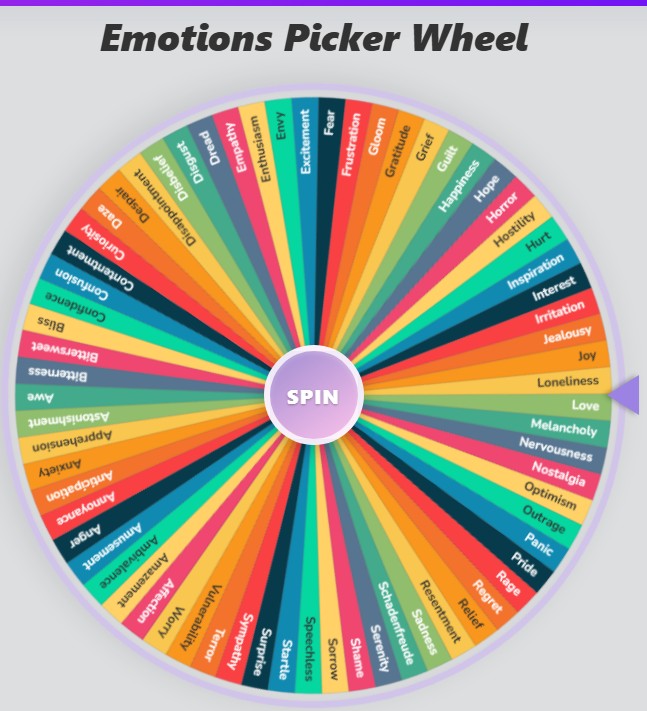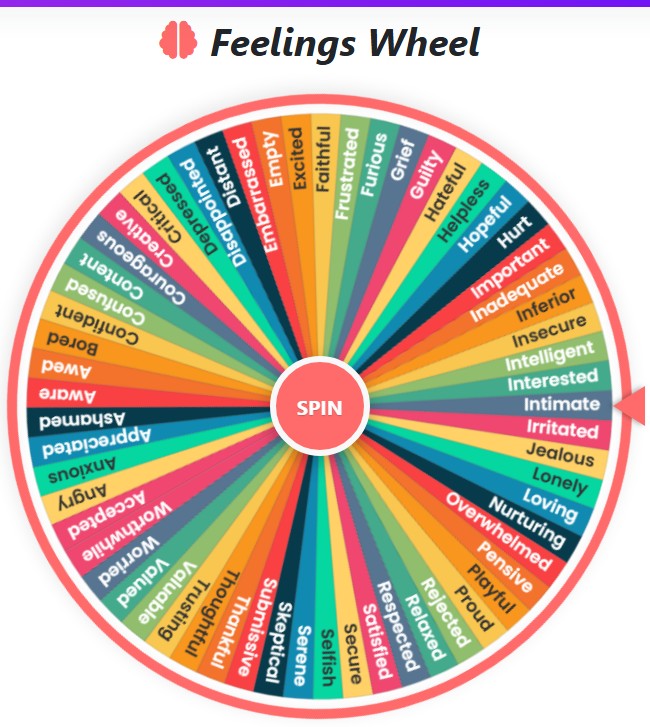Wheel of Wellness
Current Mode: None
Quick Link:
- wheel of life
- 100+ Strong Emotions
- Love Feelings Wheel
- Wheel of Awareness
- The 5 Love Language Wheel
- anger emotions wheel
- Sad emotion wheel
- Positive Emotions Wheel
Spin Your Way to a Better You: The Ultimate Guide to the Wheel of Wellness
In our fast-paced world, “self-care” can feel like another item on an endless to-do list. We know we should take better care of ourselves, but the sheer number of options is overwhelming. Should you meditate, exercise, call a friend, or read a book? When you’re already tired, making another decision is the last thing you want to do.
What if you could make self-care simple, fun, and spontaneous?
Introducing the Wheel of Wellness! 🎡 It’s a beautifully simple, interactive tool designed to take the guesswork out of your well-being journey. Instead of stressing about what to do, you can give the wheel a spin and let fate choose a small, manageable activity to boost your day. It’s your personal wellness coach, available 24/7.
Let’s start by exploring the core of the tool: the amazing activities waiting for you.
Your Wellness Dimensions at a Glance
The Wheel of Wellness is built around six key dimensions of well-being, plus an “All Activities” option to cover every base. Here is a complete list of every activity you’ll find in each category right from the start.
🤸 Physical Wellness
- Go for a 15-min walk
- Stretch for 10 mins
- Drink a glass of water
- Eat a healthy snack
- Get 7-8 hours of sleep
- Dance to a favorite song
- Do 10 push-ups
- Try a new healthy recipe
❤️ Emotional Wellness
- Write in a journal
- Meditate for 5 mins
- Practice deep breathing
- List 3 things you’re grateful for
- Listen to calming music
- Acknowledge one feeling
- Watch a funny video
🤝 Social Wellness
- Call a friend or family
- Plan a coffee date
- Compliment a stranger
- Send a thoughtful text
- Join a community event
- Share a meal with someone
- Reconnect with an old friend
🧠 Intellectual Wellness
- Read a book for 15 mins
- Learn a new word
- Watch a documentary
- Solve a puzzle
- Listen to a podcast
- Explore a new topic online
- Try a new hobby
✨ Spiritual Wellness
- Spend time in nature
- Practice mindfulness
- Reflect on your values
- Disconnect from screens
- Volunteer for a cause
- Read inspirational quotes
- Set a personal goal
🌿 Environmental Wellness
- Declutter a small space
- Go for a walk outside
- Buy a new plant
- Spend time in a park
- Tidy your workspace
- Recycle something
- Organize a drawer
🌐 All Activities
This category combines every single activity from the six dimensions above, giving you the ultimate variety for your spin!
The Heart of the Tool: A Simple Spin
The magic of the Wheel of Wellness lies in its simplicity. At the center of the screen is a vibrant, colorful wheel loaded with positive activities. In the very middle, you’ll see a large button that says “SPIN.”
When you click it, the wheel comes to life! It whirls around with a satisfying sound, building anticipation. After a few exciting seconds, it slows down and gently comes to a stop, with a sleek pointer on the side indicating your chosen activity for the moment. A little burst of confetti and a pleasant chime celebrate your result. It’s that easy!
Mastering Your Wellness Journey
Beyond the spin, this powerful tool gives you full control over your experience. The controls are intuitive and designed to help you customize the Wheel of Wellness to perfectly suit your needs.
The Action Bar: Your Command Center
Located conveniently near the top of the controls section, this bar is your go-to for quick adjustments.
- Sort A-Z: Feeling a bit chaotic? Click this to instantly arrange the activities currently on your wheel in alphabetical order. It’s perfect for when you want a more organized view in your list.
- Shuffle: Want to mix things up? The shuffle button will randomly reorder the activities on the wheel, giving it a fresh feel without changing the items themselves.
- History: Ever wonder what you’ve been focusing on? This button opens a pop-up window showing a list of your most recent spin results. It’s a great way to track your progress and ensure you’re touching on different areas of wellness.
- Color Settings: Tastes are personal, and so is wellness. This button lets you change the color palette of the wheel. Whether you prefer vibrant, pastel, or earthy tones, you can make the wheel visually pleasing to you.
- Reset All: Need a completely fresh start? This is your magic wand. It resets everything—the categories, custom items, spin count, and history—back to the original default settings.
- Spin Counter: This handy little display keeps track of how many times you’ve spun the wheel. It’s a simple but powerful motivator to see your consistency grow over time!
Choosing Your Focus: Category Selection
This is where you decide what kind of wellness you want to focus on.
- Direct Buttons: You’ll see a few primary categories available as direct buttons, like “All Activities,” “Physical,” and “Emotional.” Just click one, and the wheel will instantly populate with activities from that specific dimension. The active category will be highlighted, so you always know your current focus.
- The “More…” Button: To keep the interface clean, other categories like “Social,” “Intellectual,” “Spiritual,” and “Environmental” are tucked away in a neat dropdown menu under the “More…” button. Click it, select your desired dimension, and the wheel will update. The “More…” button will even get a special highlight to remind you that your active choice is inside.
Your Personal Wellness List
The true power of the Wheel of Wellness is its customizability. You are not limited to the pre-loaded activities.
- The Activity List: Below the category buttons, you’ll find a box that lists every single activity currently on the wheel. This gives you a clear overview at a glance.
- Add Your Own Activity: See that input box that says “Add a wellness activity…”? This is for you! Type in anything you want—”Try a new tea flavor,” “Doodle for 10 minutes,” “Plan my weekend”—and click “Add.” Your custom activity will instantly appear on the wheel. This makes the tool infinitely personal.
- Edit or Remove: Don’t like an activity? Or want to rephrase it? Simply click on the text in the list to edit it. A small ‘x’ appears next to each item, allowing you to remove it with a single click.
- Clear All: The trash can icon at the top of the list box is a quick way to clear all activities from the wheel, giving you a blank slate to build a completely custom wheel from scratch.
Why the Wheel of Wellness Works
This isn’t just a random game; it’s a tool grounded in proven psychological principles that make positive change easier.
From Overwhelm to Action
The biggest barrier to self-care is often “decision fatigue.” After a long day of making choices at work and home, the last thing we have energy for is deciding how to relax. The Wheel of Wellness eliminates this barrier. It makes the decision for you, transforming a moment of potential stress into a moment of fun and surprise. It takes a huge, abstract concept like “becoming healthier” and breaks it down into one small, concrete, and doable action.
The Joy of a Single, Simple Step
You don’t need to overhaul your entire life overnight. Real, lasting change is built on small, consistent habits. Spinning the wheel and committing to one 10-minute activity is far more sustainable than vowing to go to the gym for two hours every day and giving up after a week. This tool celebrates the small wins, and those small wins add up to significant improvements in your overall well-being. The Wheel of Wellness makes consistency feel like a game, not a chore.
Making the Wheel Truly Yours
The tool offers even more ways to personalize your journey, ensuring it stays fresh and motivating.
A Splash of Color: Palette Settings
When you click the settings icon, a modal appears offering several beautiful color palettes. This might seem like a small detail, but the colors we surround ourselves with can impact our mood. If you’re feeling energetic, you might choose the “Vibrant” palette. If you need calm, “Pastel” or “Ocean Deep” might be better. Customizing the look and feel of the Wheel of Wellness helps you connect with it on a deeper level.
Tracking Your Progress: The History Modal
The history feature is more than just a list; it’s your wellness diary. By looking back at your past spins, you might notice patterns. Are you neglecting a certain dimension of wellness? Have you been doing a great job with your emotional well-being lately? This insight allows you to be more intentional with your category choices in the future, ensuring a balanced approach to self-care.
Ready to Find Your Balance?
Your journey to a healthier, happier life doesn’t have to be complicated or stressful. It can start right here, right now, with a single, joyful spin.
The Wheel of Wellness is designed to meet you where you are. Whether you have five minutes or an hour, whether you feel energetic or depleted, there is an activity waiting for you. It’s a reminder that you deserve to take a moment for yourself and that every small step you take is a victory.
So go ahead. Give the Wheel of Wellness a spin and discover what wonderful activity the universe has in store for you today. Your future self will thank you. ✨







